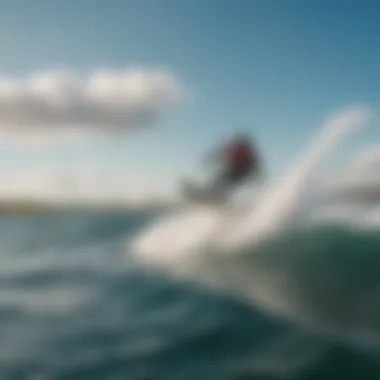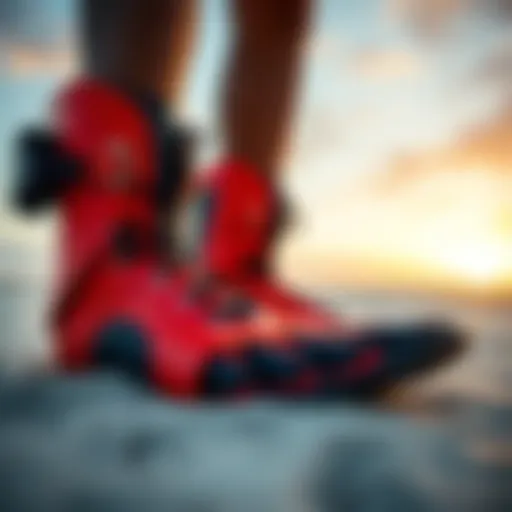Comprehensive Guide to Fond du Lac Weather


Intro
Fond du Lac, Wisconsin, nestled at the shores of Lake Winnebago, presents a weather tapestry that greatly impacts outdoor activities, particularly kiteboarding. The city experiences a variety of weather patterns throughout the year, shaping not just daily life but also recreational pursuits. Understanding these climatic conditions can make or break a kiteboarder's experience on the water.
As we journey through this article, we will unpack the specifics of Fond du Lac's seasons, revealing key insights into temperature fluctuations, wind conditions, and precipitation patterns. With kiteboarding as our focal point, each section provides essential knowledge to help enthusiasts plan their adventures effectively.
The following sections will delve into gear insights and kaiteboarding techniques tailored specifically for Fond du Lac's unique weather. We'll also explore safety practices that every kiteboarder should be aware of. By the end of this comprehensive guide, you’ll emerge equipped with a powerful understanding of how the weather shapes kiteboarding opportunities in this picturesque Wisconsin locale.
Overview of Fond du Lac's Climate
Understanding the climate of Fond du Lac is crucial for those who cherish outdoor activities, particularly kiteboarding. The region's weather can influence everything from the intensity of the wind to the likelihood of rain, which are vital for planning a successful day on the water. By examining the climate, enthusiasts can better prepare for their adventures, ensuring both safety and enjoyment.
Fond du Lac sits at a critical juncture where various meteorological factors converge. This makes it an interesting case study for both casual observers and scholars alike. Knowing the seasonal shifts allows kiteboarders to take advantage of optimal conditions while remaining watchful for potential hazards. Additionally, a nuanced understanding of climate can guide instructors and travelers in making informed choices, whether they're planning a weekend getaway or a longer stay.
Geographical Influence on Weather Patterns
The geography of Fond du Lac plays a significant role in shaping its weather. Nestled between Lake Winnebago and the nearby Kettle Moraine geological area, the city experiences a blend of influences from both land and water.
- Proximity to Great Lakes: The nearby lake has a moderating effect on temperatures, often leading to cooler summers and milder winters compared to regions further inland. Water bodies tend to retain heat longer than land, which means after a hot summer, you might still catch some warm breezes as fall approaches.
- Topographical Features: The rolling hills and valleys in the nearby Kettle Moraine area can funnel winds differently than flat regions, resulting in varied wind conditions for kiteboarders. Hills may create eddies or sudden gusts that experienced boarders can use to their advantage, but that could also surprise the unprepared.
- Urban Influence: As a small city, Fond du Lac's urban sprawl can introduce localized climate effects, often referred to as the "urban heat island" effect. Concrete and asphalt absorb heat, which can lead to warmer temperatures in the city's core compared to rural areas.
Climate Classification
Fond du Lac typically falls under the humid continental climate classification, characterized by four distinct seasons.
- Cold Winters: Temperatures can drop significantly in winter, often plunging below freezing. This makes it vital for kiteboarders to check local forecasts for wind chill factors that can affect comfort and safety out on the water.
- Warm, Humid Summers: Summers can be quite warm, with humidity levels rising. This is when kiteboarding really takes off.
- Precipitation Distribution: Rainfall is common throughout the year, but summer storms can be particularly intense. Enthusiasts should be prepared for sudden weather changes, which can lead to a swift end to an otherwise calm day.
Understanding Fond du Lac's climate is essential not just for kiteboarding but for appreciating the broader ecological dynamics at play in the region.
Through a keen awareness of the geographical influences and climate classification, individuals can refine their approach to enjoying outdoor activities. In doing so, they maximize their experience while being mindful of safety and environmental conditions.
Seasonal Weather Patterns
Understanding the seasonal weather patterns in Fond du Lac is crucial for anyone looking to engage in outdoor activities, especially kiteboarding. Each season brings its own set of conditions that can affect wind patterns, temperature, and precipitation. By being aware of these variations, kiteboarders can plan their outings effectively, ensuring a safer and more enjoyable experience on the water.
The transitions from one season to another can be quite dramatic in this region. Knowing what to expect helps in making informed decisions about when to hit the water or when to postpone an adventure due to unfavorable conditions. In short, seasonal patterns are not merely meteorological data; they are key indicators that shape the kiteboarding experience.
Winter Weather Conditions
Winter in Fond du Lac can be quite a challenge for kiteboarders. Cold temperatures often dip below freezing, which directly affects both the wind and water conditions. Ice can form on the lakes, limiting access and potentially creating hazards.
During this season, wind patterns tend to be more stable but can be quite brisk. Kiteboarders need to keep an eye on the weather forecasts to catch those perfect wind days. Also, the waterproof gear becomes a necessity, as the wind chill can make the experience uncomfortable if you're not properly equipped. Here, understanding how cold air masses interact is key to maximizing your time on the water.
Spring Thaw and Weather Shifts
As winter gives way to spring, Fond du Lac experiences a significant thaw. Temperatures begin to rise, and the ice on lakes slowly melts. However, spring weather can be very fickle.
Rapid fluctuations in temperature can lead to sudden rain showers and even late-season snow flurries. Kiteboarders should be prepared for an unpredictable ride. The shifting weather systems in spring can create exciting wind conditions, but caution is advisable as storms can form unexpectedly. This is a time when local forecasts become invaluable. They'll help you track the interplay between temperature, humidity, and wind.
Summer Heat and Showers


Summer transforms Fond du Lac into a vibrant hub for outdoor activities, including kiteboarding. With temperatures often soaring into the 80s or 90s, it’s a great time to be on the water. However, with the heat comes additional humidity and the occasional summer thunderstorms.
While many sunny days provide perfect conditions for kiteboarding, quick-moving storms can pop up, bringing strong winds and rain. When planning a day on the water, it’s a good idea to check the weather not just in the morning but throughout the day. The dynamics of summer weather mean that skilled kiteboarders can take advantage of gusty winds following a storm, but safety must always remain a priority.
Fall's Cool Breezes and Changes
Fall in Fond du Lac is often characterized by cool and refreshing breezes. As summer fades, the winds pick up and can create ideal conditions for kiteboarding. The changing foliage adds a beautiful backdrop, elevating the overall experience.
However, temperatures can drop quickly as the season progresses. Kiteboarders should be cautious of changing weather and prepare for the chill that comes with the late autumn air. This season is also marked by more stable wind patterns, making it a prime time for many to enjoy the sport. Just keep an eye out for those pesky cold fronts that can sweep through.
"Kiteboarding in Fond du Lac offers thrilling experiences, but understanding seasonal patterns is your best bet for safety and fun."
In essence, each season in Fond du Lac imparts its unique flavor to weather patterns, all of which impact kiteboarding. By staying informed and adaptable, enthusiasts can navigate these changes to make the most of their time on the water.
Implications of Weather for Kiteboarding
Understanding the nuances of weather in Fond du Lac is vital for kiteboarding lovers, as the wind and other atmospheric conditions can make or break a session. The interplay of seasonal happenings, alongside the ups and downs of local weather, holds significant implications for kiteboarders. If you plan to take to the water, knowledge of how these factors work together can lead to enhanced safety and enjoyment. Let's delve into the prominent elements that affect kiteboarding in this area, including wind variability and reading local weather forecasts.
Wind Conditions and Their Variability
Wind is the lifeblood of kiteboarding; without it, you're just standing on the beach, dreaming of soaring through the sky. In Fond du Lac, wind conditions can change with the flick of a switch, influenced by geography and seasonal shifts. During summer, for instance, warmer air tends to rise, creating wind patterns that some experienced kiteboarders love.
- Lake Winds: The proximity to Lake Winnebago offers unique wind dynamics. As the sun heats the land, the water remains cooler, creating breezy afternoons ideal for thrilling rides.
- Swirling Gusts: Sometimes, especially in spring and fall, wind can become gusty and unpredictable. Be prepared for sudden shifts that can challenge even the most experienced riders.
- Regional Patterns: It’s not just the local winds that matter, but also those patterns from nearby regions. Look out for fronts moving in from neighboring areas that can dramatically affect the conditions—sometimes for the better or worse.
Understanding these variables allows kiteboarders to make informed decisions about when to hit the water, maximizing their experience while reducing the risk of accidents.
Understanding Local Weather Forecasts
Having an eye on local weather forecasts is as critical as knowing the tides for any kiteboarding enthusiast. Knowing how to interpret these forecasts helps in planning your outings more effectively and avoiding unexpected surprises.
- Reliable Sources: Websites and apps often provide real-time data specific to Fond du Lac. Reliable options include The Weather Channel and AccuWeather for temperature, wind speed, and direction.
- Radar and Satellite Imagery: These tools enhance understanding of upcoming weather systems. The use of radar can indicate whether rain or thunderstorms might arise, which can ruin a perfect day at the beach.
- Community Networks: Local kiteboarding communities often share insights on the conditions. Checking forums on platforms like Reddit can provide valuable first-hand information about the latest conditions you won’t find in mainstream forecasts.
"A day spent on the water is more than just recreation; it’s about pushing your limits and connecting with nature. Weather plays a huge role in making those moments happen."
By keeping track of the local meteorological updates and adjusting your plans accordingly, you maximize not just your potential fun but your safety too.
With the right preparation and information at hand, Fond du Lac can be your playground, ready to embrace the thrill of kiteboarding.
Potential Weather Hazards for Outdoor Activities
Understanding the potential weather hazards in Fond du Lac is crucial for anyone who enjoys spending time outdoors, especially kiteboarders and adventure lovers. The interplay between weather and outdoor activities can have significant consequences, and being aware of these hazards allows individuals to make informed decisions that prioritize safety.
During outdoor activities, unexpected weather changes can pose a serious risk. This is particularly true in Fond du Lac, where conditions can shift rapidly. For kiteboarders, it’s not just about the thrill of the ride; it’s also about understanding the sky and what it has in store. Whether you are planning an afternoon on the water or simply enjoying a stroll in one of the area's beautiful parks, knowing about weather hazards empowers you to navigate the elements effectively.
Thunderstorms and Lightning Risks
Fond du Lac experiences thunderstorms, particularly in the summer months. These storms can develop quickly, often with little warning. The region’s geography, characterized by flat land and proximity to lakes, exacerbates the situation. Storms can bring strong winds, heavy rain, and lightning, making outdoor activities risky.
When thunder rumbles, it’s advisable to take cover. According to the National Weather Service, if you can hear thunder, you are already in danger of lightning strikes. Here are some crucial tips for kiteboarders:
- Monitor Weather Alerts: Stay updated with local weather forecasts through reliable sources like the National Weather Service or local news websites.
- Seek Shelter: Always have a plan for where to go in the event of a storm. A sturdy building is the best option.
- Wait it Out: If lightning threatens your activity, postpone your session. Safety should always come first.


"Lightning can strike up to 10 miles away from a storm. If the sky looks ominous, take it seriously."
Severe Weather Preparedness
Being prepared for severe weather in Fond du Lac extends beyond just thunderstorms. Tornadoes can occur, particularly during peak storm seasons. It is essential to familiarize yourself with local severe weather protocols, as communities often have alert systems in place to keep residents informed.
For kiteboarders, this means:
- Responsible Planning: Before heading out, check the forecast not only for your immediate activity but looking at the broader forecast for the day.
- Awareness of Surroundings: Know where you are heading and identify safe spots nearby, be it a beachside building or a public area with shelter.
- Emergency Kit: Consider carrying a basic emergency kit, including a first-aid kit and some food and water, especially if you are planning to be out for an extended period.
- Community Resources: Leverage local resources for information. Websites like Wikipedia, Britannica, and community forums on platforms like Reddit can provide relevant insights on trends and historical weather patterns in Fond du Lac.
With the right knowledge and preparations, outdoor enthusiasts, especially kiteboarders, can enjoy their time on the water while minimizing risk exposure to unpredictable weather hazards.
Historical Weather Data and Trends
Historical weather data serves as a cornerstone for understanding the patterns and rhythms of climate in Fond du Lac, Wisconsin. It tells a story, a narrative woven through years of observation that reveals how the past influences the present and shapes the future. For kiteboarders, travelers, and enthusiasts alike, these historical insights are essential for effective planning and safe outdoor experiences. By digging into the annual temperature averages and precipitation trends, you can forecast conditions that will impact activities.
Annual Temperature Averages
When one considers the annual temperature averages for Fond du Lac, it becomes apparent that fluctuations play a significant role in determining the best times for outdoor activities. Winter months tend to be quite cold, with January often being the chilliest, dropping to around 15 °F, which can make kiteboarding not ideal but offers a unique atmosphere for those seeking adventure on the frozen lake. In contrast, July usually sees peak temperatures around 80 °F, offering a perfect backdrop for summer kiteboarding.
- Winter Average: 15 °F
- Spring Average: 50 °F
- Summer Average: 80 °F
- Fall Average: 55 °F
The significant contrast between summer and winter not only affects personal comfort but also influences the equipment and techniques used by kiteboarders. For instance, lighter kites and surfing gear are essential for the summer heat, while winter enthusiasts may require specialized gear for icy conditions.
Precipitation Patterns Over The Years
The precipitation trends in Fond du Lac are equally crucial for understanding weather patterns. Over the years, the region has experienced varying amounts of rainfall and snowfall, which have implications for water levels and kiteboarding conditions.
On average, Fond du Lac receives about 30 inches of rain annually, but this amount fluctuates from year to year based on weather anomalies. The spring typically brings a surge in precipitation, which can cause lakes to rise significantly, creating ideal conditions for kiteboarding as long as the winds are favorable. One noteworthy trend is the shift in snowfall; with climate change, certain winters have seen both heavier snows and milder periods, impacting ice stability.
- Average Rainfall: 30 inches/year
- Peak Rainy Months: April, May
- Snowfall: Varies significantly, but can be heavy in January
"Understanding the precipitation patterns helps kiteboarders plan around wet conditions and take advantage of optimal weather windows."
In summary, historical weather data provides a comprehensive perspective on temperature averages and precipitation patterns crucial for those engaging in outdoor activities in Fond du Lac. From choosing the right kite for the season to anticipating how rainy weather can impact lake conditions, these insights are invaluable for ensuring a safe and enjoyable experience.
Local Resources for Weather Information
Weather Websites and Applications
With the advancement of technology, a plethora of websites and applications have sprouted, catering to the specific needs of those interested in weather forecasts. These platforms offer more than just basic data; they present a treasure trove of information that can significantly aid kiteboarders and outdoor enthusiasts in Fond du Lac.
Some notable resources include:
- The Weather Channel (weather.com) - Features detailed forecasts and radar images, which are crucial for planning a kiteboarding session.
- AccuWeather (accuweather.com) - Known for its minute-by-minute precipitation forecasts, perfect for deciding when to hit the water.
- Windfinder (windfinder.com) - Specializes in wind forecasts, helping kiteboarders identify the optimal conditions for their sport.
- MyRadar (myradar.com) - Offers real-time weather updates, which is essential for tracking incoming thunderstorms.
These modern tools enable users to filter information based on their activity needs and geographical focus. For kiteboarders, knowing the wind speed and direction is particularly important. The ability to access local weather information right from a smartphone or computer can help users make quick decisions that ensure safety and maximize enjoyment.
Community Weather Stations and Networks
Local weather stations form the backbone of real-time weather information. Many regions in Fond du Lac have community weather stations that contribute data to broader networks, offering hyper-localized reports that national outlets may miss. These stations provide critical insights into specific weather phenomena that can affect outdoor activities.


The benefits of community weather stations include:
- Localized Data: Weather conditions can vary drastically within short distances. Community stations capture this variability, offering precise forecasts tailored to specific neighborhoods or even lakeside conditions.
- Networking: Many of these stations are part of networks such as the Citizen Weather Observer Program (CWOP) or Weather Underground. This connectivity enhances the accuracy of weather reporting.
- User Engagement: Community stations often have active user bases who share tips, warnings, and firsthand accounts of current weather, adding a layer of reliability and communal support.
A great way to find local stations is through websites like Wunderground (wunderground.com), which highlights personal weather stations in your area. Users can easily find real-time weather updates and make informed decisions about kiteboarding conditions.
In Fond du Lac, your best bet for up-to-date weather conditions is local community stations paired with advanced weather apps. These resources provide you with the insights needed to make informed decisions regarding outdoor activities.
Being proactive about checking these resources not only aids in having a fun day out but also promotes safety amid changing weather conditions. Whether you're a beginner or a seasoned kiteboarder, familiarizing yourself with these local tools can deepen your appreciation for Fond du Lac's unique weather landscape.
The Role of Meteorology in Kiteboarding
Kiteboarding is not just about the thrill of riding the waves; it’s heavily influenced by the atmospheric conditions that govern the water and wind. In Fond du Lac, Wisconsin, understanding the weather can mean the difference between an exhilarating session and a dangerous experience. Meteorology, the study of weather and atmospheric phenomena, plays a pivotal role in this sport.
Kiteboarders rely on several meteorological factors to optimize their experience: wind speed, direction, and patterns, as well as general weather conditions. With each season bringing its own quirks, a solid grasp of these variables allows kiteboarding enthusiasts to choose the right days for action and stay safe while riding.
Meteorological Principles Relevant to Kiteboarders
When considering kiteboarding in Fond du Lac, several key meteorological principles come into play.
- Wind Speed and Direction: Wind is, without doubt, the lifeblood for kiteboarding. A kiter needs a consistent wind speed ranging typically from 10 to 25 knots. Too little wind leaves you floundering, while too much can lead to dire consequences. The direction of the wind matters as well; side-onshore winds are usually ideal, providing a steady pull without pushing the kiteboarder too far out.
- Thermals: As the sun heats the Earth's surface, warm air rises, creating thermals. In particularly sunny days, thermals can enhance the wind conditions, leading to fun and extended kiteboarding sessions. However, kiteboarders should avoid areas where thermals can be unstable or highly gusty.
- Cold Fronts and Warm Fronts: Understanding the shifts in fronts is vital. Cold fronts usually bring in rapid changes in wind patterns and can intensify winds dramatically. A warm front may result in more stable conditions, which can be perfect for beginners.
- Local Geography: The geography of Fond du Lac itself influences wind flow. Factors like nearby lakes and hills create microclimates that can alter expected conditions. Being familiar with these geographical influences helps kiteboarders anticipate changes.
How to Interpret Cloud Formations
Clouds tell stories about what’s happening in the atmosphere and can be essential for a kiteboarder’s planning. Here’s how to decode them:
- Cumulus Clouds: These fluffy, white clouds usually indicate fair weather but can develop into larger cumulonimbus clouds, especially in summer, raising a red flag.
- Stratus Clouds: A blanket of gray clouds often brings steady rain, not ideal for kiteboarding. If you notice this, it might be best to steer clear of the water.
- Cumulonimbus Clouds: These towering giants signify thunderstorms. If you spot these clouds looming nearby, it’s time to pack it up and head for safety. Lightning during a storm can be deadly, especially on open water.
- Cirrus Clouds: Thin and wispy, these clouds are often a sign of fair weather ahead, so seeing them can ease worries for a kiteboarding session.
Understanding these cloud patterns helps kiteboarders to make real-time decisions based on the shifts in weather conditions.
Being in tune with the weather—both its immediate signs and overall patterns— is invaluable for kiteboarders in Fond du Lac. With the right insight and a little bit of practice, kiteboarders can turn challenging conditions into thrilling adventures while avoiding hazardous situations.
The End
In this comprehensive exploration of Fond du Lac's unique weather conditions, we've uncovered not just the surface-level data but also the intricate nuances that affect outdoor activities, particularly kiteboarding. Understanding the local climate is essential for both safety and enjoyment, especially in a region where weather patterns can shift rapidly.
The significance of meticulously preparing for varied weather scenarios stands out clearly in our discussions. Kiteboarders, for instance, should recognize not just when to paddle out, but also why certain conditions may create treacherous or minority favorable conditions, potentially altering their experience on Lake Winnebago.
Final Thoughts on Weather Preparedness
Being prepared is more than just having the right gear; it’s about understanding your environment. For Fond du Lac, preparation includes glossy knowing the seasonal fluctuations, from how winter's biting chill might sway your kiteboarding opportunities to how sudden summer storms could turn a perfect day on the lake into a cloud-drenched disappointment.
Here are a few key points to consider for effective weather preparedness:
- Stay Updated: Weather can be fickle. Always check reliable sources like the National Weather Service or local news channels before heading out.
- Know Your Limits: Don’t just gauge conditions through metrics like wind speed; trust your instincts. If it feels off or if the forecast suddenly changes, it’s better to air on the side of caution.
- Invest in Technology: Utilize apps like Windy or SailFlow, which can give you real-time updates on wind patterns that are crucial for kiteboarding.
It pays to remain vigilant and equipped with the right knowledge and tools.
Encouragement for Safe Kiteboarding Practices
For kiteboarding enthusiasts, the beauty of the sport is most exhilarating when it’s approached safely. Fond du Lac offers some incredible opportunities, but embracing safety as a core principle can literally make the difference between a thrilling adventure and a harrowing episode.
Here are a few practices to keep your sessions enjoyable:
- Always Wear a Harness: It may seem like a basic tip, but having the appropriate gear can make operations much easier and safer.
- Buddy Up: Kiteboarding is always better with a friend. Not only does it enhance the experience, but in case of an emergency, you have someone to assist.
- Know the Area: Familiarize yourself with the locations that are suitable for kiteboarding. Not all spots around Fond du Lac are equally conducive; some are safer than others in specific weather conditions.
- Respect Nature: Always follow local regulations regarding waterways and natural reserves. These regulations are in place for your safety and the preservation of the environment.
Kiteboarding should be a stimulating yet safe experience. By understanding the weather intricacies unique to Fond du Lac and putting these practices into action, kiteboarders can maximize their enjoyment while minimizing the risks. Safe adventures lead to great stories; embrace every element nature throws your way!















